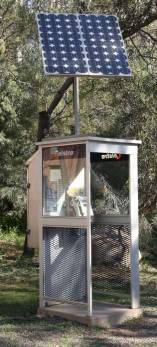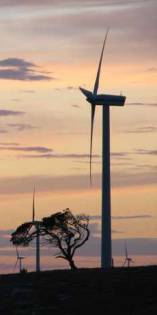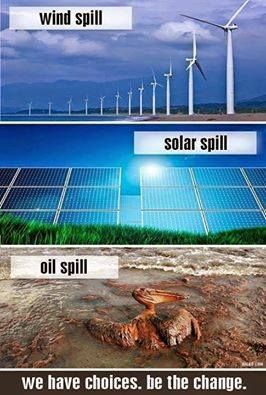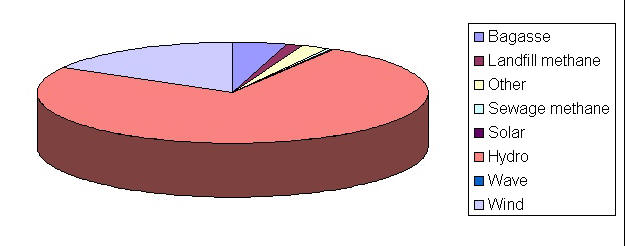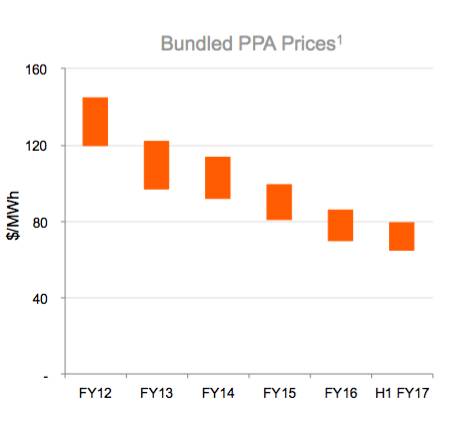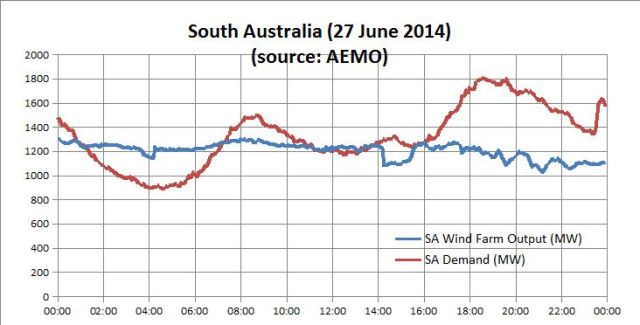Characteristics of various generation technologies
|
|
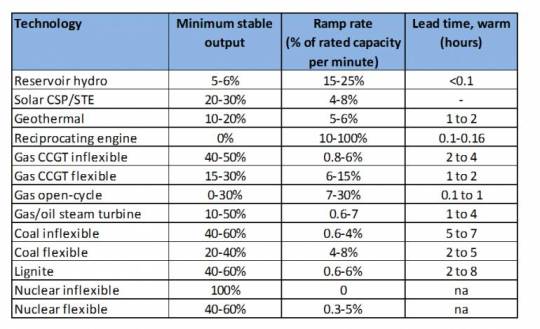
| | Table source: International Energy Agency, 2014: The Power of
Transformation: Wind, Sun and the economics of flexible power systems
| |
The table on the right shows that hydro power has several advantages over
other forms of power generation in its flexibility.
It can be run at a great range of rates and can be 'ramped' up or down to
suit demand very quickly.
| |
Pumped hydro power study in Australian National University
Ecogeneration published an informative piece about a study on the
pumped hydro power potential in South Australia, Queensland, Tasmania and the
ACT on 2017/08/09.
The study was headed by Professor Andrew Blakers.
The group was next to look for sites in NSW, Victoria, Western Australia and
the Northern Territory.
Blakers pointed out that for Australia to develop a high percentage of
renewable energy both energy storage and increased long-distance power
transmission would be required.
Balancing generation and load
See also balancing
generation and load elsewhere on this page and
balancing
the electricity grid on my page on sustainable electricity discusses
ways of varying consumption to help match the rate of generation.
"The missed energy storage technology"
Written by Tristan Edis and published in Business Spectator on 2014/03/03.
Tristan's
piece
refers to a study by the University of Melbourne's Energy Institute and
discusses the heretofore largely overlooked potential of pumped hydro in
Australia.
The Dutch are so committed to wind energy that they are seriously
considering building an "energy island" in the north sea.
(The Netherlands, being very flat, does not have hydro-power or potential
hydro-power in the 'normal' sense.)
The idea involves building a circular dam in water about 20m deep, creating
a controlled storage area several kilometres in diameter.
The water will be pumped out of the storage into the sea when wind farms have
put plentiful and cheap energy into the grid, it will be allowed to flow
back in through turbines when the electricity in the grid is in short
supply and its price is high.
See Times Online.
Brave new climate, a pro-nuclear blog site, discussed a pumped
storage 9GW hydro power system, costed by Peter Lang,
that could be set up between two major existing dams in NSW,
Blowering and Tantangara, at a cost of $7b to $15b.
It's 53km tunnel length would make its use for quick response to
changes in supply and demand in the grid impractical.
Peter Lang wrote this piece with the expressed aim of showing new pumped-hydro
schemes are unviable and therefore that incorporating large amounts of
renewables into the electricity grid is impractical.
|
|
An electricity supply system (power grid) has to continually balance supply
and demand.
Total electricity consumption must, at all times, be matched by generation.
Renewable energy forms such as wind and solar are, by their nature, variable
in the amount that they generate and totally dependent on whether (and how
strongly) the wind is blowing or the sun is shining.
Consumption, too, is variable.
It follows that there must be some source of electricity available
on demand to balance the grid.
Pumped-hydro is one such; it can be quickly started and stopped as needed.
At present gas-fired generators are most commonly used, at least in
Australia, to balance supply with demand, but gas-fired power is
unsustainable and we must eventually move to sustainable power.
It doesn't matter what causes any inbalance between supply and demand.
An excess of power in the grid could be due to many wind farms generating
strongly at the same time or to low demand for power in the early morning.
A deficiency of power in the grid could be caused by the wind
not blowing or to a jump in demand due to many air-conditioners being
used on an unusually hot day.
What matters is that pumped-hydro can help to provide the needed balance.
Denmark obtains about 20% of its power from wind (World Wind Energy Report,
2008) and buys hydro-power from nearby Norway as required to fill in any
short-fall in power supply when the wind is insufficient.
Not only can hydro-power be fed into the electricity grid when there is a
shortage of supply and the wholesale price is high, but energy can be
stored as potential hydro-power when there is an excess of electricity and the
wholesale price is low.
Instead of generating power from falling water, power can be used to lift
water from a low-level storage to a high-level storage (see
Pumped-storage hydroelectricity in Wikipedia).
Reduced run-off into hydro-power catchments in recent years is a major
problem for the operators of hydro-power stations, but it could to some
extent be overcome by developing pumped recycling of the
limited water in the system.
Tumut 3 Power Station in the Snowy Mountain
Scheme of NSW, for example, is set up for pumped-storage.
In generating mode water can flow from the upstream storage, behind
Talbingo Dam, through anything up to six turbines into the downstream
storage, behind Jounama Dam.
At times when electricity is plentiful and cheap, two (or three?) of the
Tumut 3 turbines can be used as pumps to lift water from the Jounama
pondage up into the Talbingo reservoir.
In effect, electricity is stored in the form of the potential energy of the
water in the high storage.
This system can be, I believe, about 80% efficient.
I know of no new development of pumped-storage hydro in Australia aimed
specifically at balancing the grid since wind power has become a major
component of our power supply; apparently using gas-fired power stations
to fill in the gaps when the wind isn't blowing are
a cheaper option in the short-term.
Existing pumped hydro in Australia
(Extracted from
Peter Lang's
comment No. 95 in the Brave New Climate article
on the Tantangara-Blowering proposal.)
The energy storage capacity is 5GWh per day and 20GWh total.
The estimated total energy storage capacity per 6 hour day is:
- Wivenhoe = 1,968 MWh (1,640 MWh for 5h average pumping per day)
- Tumut 3 = 2,378 MWh
- Kangaroo Valley = 630 MWh
- Bundeela = 315 MWh
- Total = 5,290 MWh
| |
|
This paragraph added 2016/06/27
|
|
Andrew Blakers on The Conversation, 2014/07/09 wrote
"Initial estimates suggest that the cost of an off-river system at a good site
is around Aus$1,000 per kilowatt of installed capacity."
Peter Lang provided the
following:
"World experience is that hydro projects cost about US$2,000/kW to US$4,000/kW.
The Electricity Storage Association gives a range of costs for Pumped-Hydro
of US$500/kW to US$1500/kW."
On this page I have used $2000/kW ($2 per Watt) for my calculations.
This is, of course, the capital cost of building the facility.
Once built, profitability depends on how often it can be used, how much
electricity it can generate at each cycle, and the difference in the buying
and selling price of the power.
Cost of wind power
I have used $150/MWh as the buying price for the pumping power in these
calculations.
I have calculated that the
cost of production of wind
power is around $74/MWh.
I have calculated the
capital costs of wind power in
Australia at around $2.00 per installed Watt, or $6.00 per generated Watt
(the weighted average capacity factor of Australian wind farms is 34%).
|
| |
Investigation of February 2017
The
ABC reported on an investigation being carried out by Energy Australia
with funding from ARENA.
This was looking into an installation in the Cultana area, SW of Port
Augusta; a power rate of 100-200MW for up to eight hours was reported –
that is a total of from 800 to 1600MWh of energy.
Supposing a difference in altitude between the lower and upper reservoirs of
200m, which seems reasonable for the hills in the area, this installation
would require a reservoir size of about 2GL.
(This can be compared to the capacities of existing reservoirs in northern
SA: Baroota, 6.1GL; Beetaloo, 3.2GL; Bundaleer, 6.4GL.
The Tod River Reservoir near Port Lincoln has a capacity of 11.3GL.)
|
|
In early 2011 South Australia had more wind power per capita than any
nation on Earth with the possible exception of Denmark, and this will
increase by about 22% when
Snowtown Wind Farm Stage
2 is completed in late 2014.
The variable output of the wind power must somehow be matched with the
variable demand in the grid, at present this is done by a combination of
gas-fired generators and bringing power in from the eastern states, but
pumped-hydro could also have a place.
SA has few mountain ranges of any significance and generally low rainfalls,
so pumped-hydro opportunities are not easily found.
What is needed for an efficient pumped-hydro system suitable for
short-notice balancing power supply and demand?
- Water storages at a high and low level;
- The bigger the better and the greater the vertical distance between
the high and low storages the better (small distances must be matched with
bigger storages).
- Water to fill the storages;
- As the water can be used over and over again, this is not quite such a
problem as in conventional hydro-power.
Sea water is plentiful and widely available, but its use presents some
environmental challenges.
- A relatively short distance between the two pondages;
- Close proximity of the two storages is ideal to minimise both the
friction losses (and therefore required diameters of tunnels and pipes)
and the inertia of the water in the tunnels and pipes, so allowing quick
response to changes in the supply-demand balance in the power grid.
- A suitable location
- The site must be close to either the wind generators, a high capacity
power line, or a large market for electricity.
(Any of the above would be acceptable, all of the above would be ideal.)
How big a storage?
A few hundred megalitres at altitudes differing by about 100m is sufficient
for smoothing the power from one wind farm over a period of a day, and this
seems to be the most economical size.
(The
energy from 100ML falling 100m
is 27MWh – this is roughly equal to the energy from six modern (2016),
utility scale, wind turbines running at full power for an hour.)
At least hundreds of gigalitres with an altitude difference of 100m
would be needed to smooth the output from all the wind farms in SA over
a period of weeks.
Sites suitable for such large storages are probably not available in South
Australia, but may be in the Great Dividing Range in the eastern states.
Where are suitable sites available in SA?
Basing a small pumped-hydro systems on existing water reservoirs such as
Little Para and Mount Bold may be viable, but the altitude difference would
only be around 40m.
A smaller reservoir could be built close on the downstream side of the
existing storages and water
shuttled between the new lower storage and existing higher storage.
The most obvious source of large volumes of water is the sea.
If sea water is to be used then where are there elevated areas suitable
for storages of considerable size close to the coast and close to the
power grid?
There are few such places; the north coast of Kangaroo Island (both the
main part of the Island and the Dudley Peninsula) is one, the southern
Fleurieu Peninsula is another.
There are some moderately elevated areas along the western coast of Eyre
Peninsula, but they are not suited for building large water storages.
| |
Environmental considerations
If sea water is to be used then of particular concern is the probable
seepage of this into whatever aquifers might underlie the storage.
Kangaroo Island generally has very poor (in quality and quantity) groundwater
resources, but obviously investigation would be needed.
It may be necessary to line the storage with a water-proof membrane and
to control the build up of natural groundwater outside the membrane; this
would minimise the possibility of slumping as well as protecting the
groundwater from contamination.
Size of components
Instead of one large pump of 250MW and one turbine of 125MW several smaller
pumps and/or turbines would give greater flexibility in operation, albeit
at increased capital cost.
My calculations indicate that a pipe diameter of six metres would be about
right (giving a flow velocity of 5.2 metres per second and a friction
head loss of 1.8m at the full flow rate of 146 cubic metres per second).
Why generators having half the capacity of the pumps?
Australian wind farms have a
weighted average capacity factor of 34%.
If a pumped-hydro scheme is to smooth the power output from wind farms it
would apear to be ideal that it can absorb 66% of the power output when
the wind turbines are running at full output and generate about half that
when the wind turbines are not generating anything.
This may well be an over-simplification.
|
|
| |
Hill-top storage – Fleurieu Peninsula
In the main text I have looked at storages based on damning gullies.
This is an example of a storage that could be built on a hill-top.
At Latitude S35.541, Longitude E138.157, it would be possible to build a
storage with a circumference of about 2km, an average depth of 20m, an
altitude around 150m about 700m from the sea.
This would yield up to 800MWh of electricity.
This was picked out in a few minutes; a more thorough search would produce
better sites.
|
|
A search using Google Earth suggested to me that the best areas in South
Australia for pumped-hydro were on Kangaroo Island and in the vicinity of
Starfish Hill on the western coast of Fleurieu Peninsula.
(I have discussed the great untapped wind power potential of Kangaroo
Island on
another page.)
Storages of around 10GL are potentially available on Kangaroo Island
at altitudes of more than a hundred metres and within two or three
kilometres of the coast (an effective slope of around 40 to 60m/km).
Kangaroo Island is 150 to 200km (depending on the rout taken) from the
main power market in South Australia, Adelaide.
10GL at 170m elevation has a potential energy of around 5GWh, which
would be sufficient for smoothing the output from several hundred turbines
for periods of a day or so, or around a hundred turbines for a much longer
period.
(Peter Lang,
referred to above, wrote that Australia's
pumped-hydro energy storage capacity was "roughly 5GWh can be stored per
day and 20GWh total".)
If the pumps and generators were 250MW they could run for 20 hours.
Based on a cost of $2000/kW this gives
a total capital cost of $500m.
My calculations on Cathedral Rocks Wind Farm (see below and in the box
on the right) suggest that
it would be desirable if the pumps have twice the capacity of the
hydro-generators; so perhaps 250MW in pumps and 125MW in generators (maximum
operating time 40 hours) would be preferable.
So a capital cost of $375m might be more appropriate.
I will assume that power from the facility can be sold for about three times
the buying price.
(Peter Lang used $150/MWh buying and $600/MWh selling; I will use
$150/MWh buying for pumping and $450/MWh selling from generation.)
Supposing four hours of pumping at 250MW and eight hours generating at
125MW each day, an effeciency in each operation of 85% (combined efficiency
about 72%, which I believe is conservative), we can calculate
annual pumping costs of about $64m, generation income about $140m, a
gross profit of $75m and a pay-back time of 5 years.
100GL-plus storages, if they could be found at similar altitudes, could
smooth the output of
a large part of SA's wind power generation for periods up to a few weeks.
If the costs are dependent mainly on the capacity of the pumps and
generators then the greatest possible storage is a high priority.
|
|
| Model of operation of Cathedral Rocks wind farm with additional
pumped-hydro
|
|---|

| | See text for explanation
| |
Peter Seligman suggested to me that
Cathedral Rocks Wind Farm
would be a good place to set up a hydro-power scheme to smooth the generation
output of the wind farm.
His idea was to pump from the sea at the base of the nearby cliffs into
a cliff-top storage when power was plentiful and then to run the water through
a hydro-power station back into the sea when the wind farm was not generating.
Not only would a system like this allow power to be fed into the grid at
times of low generation, but it could profitably divert wind-generated
electricity from the grid at those times when there was excess generation.
(At such times a penalty is payable by the wind farmers.)
I did some calculations based on this idea.
The dark blue line on the graph shows the power actually
generated by Cathedral Rocks
wind farm on 2011/02/25 (AEMO data); there was strong generation early
in the day and very little from midday to about 2200hrs.
When wind generation was plentiful, early in the day, I modelled diverting
power from the turbines to a pump that lifted water from the sea
to a cliff-top storage; this power is shown by the pink line.
When the wind dropped (hour 7 and then hours 9 to 21) I ran water from the
cliff-top storage through a hydro-power station; this power is shown by
the yellow line.
The aqua coloured line shows the final, smoother, output from the combined
wind and hydro station into the grid.
In effect, some of the power from the early morning generation was stored
and then fed into the grid later in the day when the wind stopped blowing.
My model was a very simple one.
In reality one would have to give serious consideration to the need for
variable pumping rates and variable rates of hydro-generation.
For the sake of efficiency it may be necessary to have several pumps of
different sizes and several hydro-generators of various sizes; I have
just used one in my model.
The cliff-tops at Cathedral Rocks are rather more than 100m above sea level;
I used 100m as the altitude for the hypothetical storage.
As mentioned elsewhere
in these pages 2.7MWh is required to raise 1GL by 1m.
The calculations assumed an efficiency of 85% for the pump and the same
for the hydro-power generator.
The pump had a capacity of 30MW; 15MW would be sufficient for the
hydro-generator (the installed capacity of the wind farm is 66MW).
The cliff-top storage needed a capacity of 500ML, which could be handled
by a reservoir about 330m long, 250m wide and 6m deep.
This would be sufficient for smoothing one day's output, a larger storage
would be needed if smoothing was required over a longer period.
The pipe for pumping would need to be about 2.5m in diameter, a slightly
smaller one would suffice for the hydro generator.
